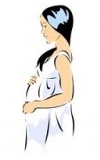What could possibly go wrong with women?
Mastitis
- Aconite–Nursing mother gets a cold which comes on suddenly with high fever; etiology: cold dry winds, cold then disappears and goes to the breast. Sensations: heat, inflammation, numbness and tingling. Belladonna has more local heat than Aconite.
- Apis–Swollen, painful with stinging pains, worse heat, better cold applications. Thirstless.
- Belladonna–Sudden onset with heat and congestion, high fever, worse being jarred. Throbbing. Right breast.
- Bryonia–Worse slightest motion, the woman is “carrying” her breasts for support, sharp stitching pains.
- Chamomilla–Etiology is anger. Hypersensitive to pain, inconsolable, whiny, complaining, irritable, volatile.
- Hepar sulph.–A later stage Chamomilla. Worse cold, worse slightest draft of air, refuses to be examined because breasts are hypersensitive to touch, abscessed breast, very painful, the slightest touch and they will scream.
- Mercury–Fever, malaise, chills, sweating, abscess, blocked ducts, thirsty with a lot of saliva, sharp radiating pain, sweating does not relieve. May be worse for both heat and cold.
- Phytolacca–more than 50% of the time, the remedy for mastitis is Phytolacca. Painful nipples, blocked ducts, lumpy breasts, breast cysts, swelling, pain, congestion, sharp radiating pains in all directions, favors the right side.
- Pulsatilla–Fever, thirstless, swollen and painful, weepy, wants consolation, better for fresh air, worse warm stuffy rooms.
- Silica–Abscess (Mercury, Hepar), cracked painful nipples, scars from surgery, hard lumps in breast, breast cysts, sharp pains, retracted nipples, fistulas, nipples ulcerate easily.
- Bellis Perennis–Breast cyst caused by injury. Cysts that are removed, such as ganglion cyst, show up later in the breast.
Hemorrhage Case-Taking
- What is the cause?
- What color is the blood?
- With or without clots?
- Active or Passive?
- What are the modalities? (things that make it better or worse)
- What are the concomitants? (things occurring along with it–pain, fear, nausea, exhaustion, cold perspiration, thirst, etc.)
- If there’s pain, what is the sensation?
Hemorrhage
Black Stringy Blood–Crocus
Active–Belladonna (bright red and hot), Phosphorus, Ipecac, Sabina
Bright Red Blood–Phosphorus, Ferrum phos., Sabina, Ipecac (with clots: Sabina, Belladonna, Arnica)
Gushing Hot Blood–Aconite, Belladonna
Intermittent Flow–Phosphorus
Bleeding After Physical Trauma–Bellis perennis, Millefolium, Arnica
Bleeding From Emotional Excitement–Chamomilla, Phosphorus, Ignatia, Coffea
Bleeding From Fibroids–Sabina, Folliculinum, Hamamelis (passive bleeding of dark blood)
During and After Labor–Phosphorus, Ipecac, Hamamelis (passive, dark), Sabina, Arnica, Belladonna
Here’s an important tip: There’s only one remedy listed under “Female, bleeding, labor, prevents hemorrhage”– and that is Arnica.
Bleeding From Retained Placenta–Caulophyllum, Sabina, Belladonna, Ipecac, Pulsatilla
Vaginitis
Staphysagria–“Honeymoon pruritis vulvae” with burning. Pruritis means itching. Here the idea is that the condition is caused by sex. Same for “Honeymoon cystitis” which is also Staphysagria.
Platina–Itching with numbness and hypersensitivity. Formication (sensation of bugs crawling). Itching, voluptuous (that means pleasurable scratching). Very sexually active.
Agaricus–Formication. Itching and burning is so violent, they can scratch until bleeding occurs. Deep itch. Itching drives them crazy.
Sulphur–When the infection is worse for heat and worse for hot bathing.
Rhus tox–Itching, ameliorated by very hot compresses, hot showers, hot bathing, the opposite of Sulphur.
Caladium–Extreme itching, better cold water, cold compresses.
Natrum phos.–Issues of acid/alkaline imbalance. If they tell you they can’t eat certain foods or drink alcoholic beverages without getting a cream-like or honey-like discharge, think of Nat-phos. Plus, if vinegar douches helped them, think of Nat-phos.
Medorrhinum–If you don’t know what to do with a bladder infection or vaginitis, give a dose of Medorrhinum 30C. Etiology–high sex drive, a lot of sexual activity, many bladder infections, yeast infections, discharges and pelvic infections, all indicative of the sycotic miasm; thick, white, burning and itching discharge; but, with the same etiology, Medorrhinum has helped even when the discharge is yellow, yellow/green, watery, etc.
Chronic vaginitis since gonorrhea. Fits the picture of the acute flare-up, Thuja more for the chronic case. For the acute case, a dose of 200C or 30C three times a day for 2 or 3 days; and for a chronic case, 6C three times a day for a month. Of course, you have to tailor this schedule to conform with how your patient is responding. See my FAQ article for case-management tips. It’s on my website.
Two key symptoms for Medorrhinum are a history of herpes and venereal warts. Thuja has more yellow/green discharges, more chronic and less intense than Medorrhinum. When sycotic discharges are suppressed, they form left-sided ovarian cysts and fibroids.
Kali bichromicum–What is it they always say? “If the mucus is thick, use Kali bich.!” Thick, ropy, stringy, lumpy, jelly-like, yellow-green discharge. If Kali bich. doesn’t work, think of Mercury. And by the way, Merc-viv. and Merc-sol. are essentially the same thing, so, either one, it doesn’t matter.
Pulsatilla–Yellow-green or yellow, thick, creamy, bland (or acrid too, apparently; though we usually associate Pulsatilla with bland discharges, meaning they don’t burn or irritate), changeable discharges.
Hydrastis–Think of it if Kali bich. fails. Thick, yellow, stringy, ropy discharge.
Hepar sulph.–Thick, yellow, acrid discharge. Whole area is hypersensitive. Very painful. Cheesy discharge, like cottage cheese.
Sepia–Bearing-down sensation, heavy feeling. Etiology could be the birth control pill or events and things that change the hormones, like PMS, pregnancy, childbirth, menopause, etc.
Ignatia–Etiology is most often emotional upset, anger, frustration, grief, bad news, shock of bad news with crying, sobbing, etc.
Natrum muriaticum–Watery or egg white-like discharge or herpes with vaginitis. Etiology could be chronic grief. Ignatia is more acute.
Miscarriage Case-Taking
- Check for etiology (examples: fright, excitement, injury , hormonal problems, vomiting, etc.)
- Look at the symptoms, especially of the blood (see “hemorrhage” section)
- Look at the concomitants (backache, headache, nausea, weakness, etc.)
- Uterine symptoms (refer back to the “menstrual cramps” section)
Miscarriage
Sabina–It’s the first remedy you should think of, unless there’s some etiology that takes you away from it. Bright red blood with clots. Sharp pain from pubis to sacrum.
Ipecac–Miscarriage plus morning sickness. Ipecac almost always involves nausea and vomiting as a concomitant. Bright red blood with severe uterine spasms.
Caulophyllum–Inertia/atony/weakness of uterus with tendency to miscarry, with exhaustion and weakness.
Sepia–Tendency to miscarrry with history of miscarriages or abortions that weaken the uterus and history of hormonal problems or the birth control pill. Miscarriage plus morning sickness.
Kali carbonicum–Severe backache with sharp, stabbing pain as a concomitant.
Apis–One of the main remedies for toxemia of pregnancy (protein in the urine, high blood pressure) along with Cicuta and China. Edema and swelling. Burning and stinging pains, worse heat.
Labor
Hint: The mentals come first! If they’re weepy and are better for consolation, give Pulsatilla; if they’re irritable, fussy, angry and rude, give Chamomilla; if they’re hysterical, can’t relax and their neck and shoulders are tight anticipating the next contraction, or you hear a lot of sighing, give Ignatia.
Pulsatilla–Weak labor, pains are feeble, everything’s slowing down, failure to progress, ineffectual labor, irregular labor, short labor pains. Acute pains in back and thighs. You might also see the Pulsatilla mentals: weepy, wanting consolation, better for sympathy and comforting. Infection and fever after childbirth, also PYROGEN and Arnica.
Cimicifuga–They say if you take a dose of this in the last month, it will shorten labor and ease after-pains. No potency was mentioned, but, perhaps a 30C. Displaced labor pains to hips, thighs or back. Back labor. Pain across pelvis from hip to hip. Sick feeling with exhaustion. Screaming. Pains can be violent, aching, shooting and/or wandering. Better pressure, warmth and fresh air. Back pain can extend down thighs. After-pains with great sensitiveness and intolerance to pain. Slow labor pains with nervous shivers. Thirsty for cold drinks, little at a time. After pains.
Caulophyllum–Exhausted. Severe tiredness and weakness, prolonged labor, ineffectual labor (#1 remedy), irregular labor, short labor pains, weak labor, rigidity of os (won’t dilate).
Coffea and Opium–Very sensitive to pain, noise and vibrations.
Coffea–Pains are ineffectual and violent, follow each other in quick succession, attended by great agitation and tossing about.
Opium–Pains suddenly stop, stupor, red face, snoring.
Nux vomica–Irritable, impatient. Backache, back labor. Feels toxic and sluggish as if she had a hang-over. Ineffectual, irregular labor.
Rhus tox–Restless, can’t get comfortable, back is stiff and achy.
Arnica–Feels beat-up and bruised, restless, can’t get comfortable, labor pains exhausting, long and painful, violent; doesn’t want to be approached or touched, won’t let you examine her. The mother will surely need a dose of Arnica 200C after delivery if she hasn’t had one already and the baby may need a dose of Arnica 30C if it was a difficult delivery. How do you give Arnica to a baby? If you’ve got a pellet of Arnica 30C in a spring water bottle, just pat the baby’s lips with it, she (or he) doesn’t have to swallow it. After pains.
Kali carbonicum–Back labor, pain extends down thighs, inefficient labor, displaced (for example, feeling labor pains in the legs. Cimicifuga also.) The Kali’s tend to have sharp pains, better pressure. Kali Carb is listed as the #1 remedy for back labor; Nux vomica is next, then Cimicifuga.
Ipecac–Cutting pain from left to right. Nausea during labor. (Vomiting may also be present as is almost always the case with Ipecac.)
Chamomilla–Labor pains excessive. Face red but one cheek may be redder than the other. Crabby, fussy, irritable, anguished, great mental excitement, overly sensitive to pain, yells, orders people out of the room, opposite of Pulsatilla which is better for consolation. Irregular labor (Cimicifuga).
Veratrum alb.–Totally exhausted. They may feel like they’re going to faint. May demand ice or ice cold drinks, may be cold with cold sweat especially on forehead.
Colocynth and Ignatia–Fainting from labor pains.
Aconite–Fear of death during labor. Also Arsenicum. The difference is, Arsenicum is afraid of dying but Aconite is less prostrated, not as weak as Arsenicum, not as cold as Arsenicum, and is quite sure she is dying now. With Arsenicum, it’s more anxiety, more that she’s “going to” die, and she wants someone very close, holding her hand, the farther away you are, the worse she gets. Aconite may have palpitations, a bounding, full pulse, congestion to the head, flushed face, hot skin, may be screaming, very thirsty.
Gelsemium–Rigidity of the os. Child goes the opposite way with each contraction.
Ignatia–Ignatia has rigidity of the os because she can’t relax. Think again of Ignatia’s emotional upset, sobbing, hysteria, etc.
Belladonna–Pains appear suddenly and disappear suddenly. Rigidity of the os due to congestion, inflammation, redness, congestion of the head with throbbing, red and bloated face, sweating, violent bearing-down pains, tossing about.
I’d like to end this section with an Arnica story. This is from Dr. Dorothy Shepherd’s book A Physician’s Posy page-19:
“Let me give you a few examples of the effect of Arnica upon animals. One of our bitches, during whelping, was found to have taken a strong dislike to her new-born puppies. She refuse to accept them and ran away from them when they were given to her to nurse. She stood there shivering and nearly trampled on them in her desire to get away. We had visions of having to find a foster mother, such as a cat in milk, which was not too easy a procedure. But after she had whelped for the fourth time, I bethought myself of Arnica as a remedy for shock. She was a very sensitive bitch, much petted and fussed over, and she could not understand the pain and discomfort of labour and these squealing, wriggling puppies around her. Arnica was given to her on the assumption that she was suffering from shock to the nervous system and when the fifth puppy arrived, she deigned to take notice of it, started to lick it and allowed it to feed. She was then left, as it was felt she had finished whelping. Two hours later she was visited again and we found she had produced a sixth puppy, which she had cleaned herself and removed all traces of labour, and was lying contentedly on the straw, warming, nursing and licking the puppies, as any ordinary well-behaved mother would do.”
Episiotomies and Caesarians
Calendula–Weak after surgery. Infected after surgery–incision is pus-filled. Cutting pains, stinging pains, burning… Heals all wounds, surgical and otherwise. Antiseptic. Take internally (30C three times a day for 2 or 3 days) and apply externally as a cold application for pain. For instance, drop a 30C pellet in a disposable cup of water and pour the water on a clean cloth and hold the cloth against the area as often as needed.
Staphysagria–Same as Calendula, for surgical pains, wounds. Take internally. Great for post-surgical complaints in general.
Phosphorus–Ailments from anesthesia, such as nausea, weakness. Desire for ice and cold drinks.
Pyrogen–Infected after surgery. Fever after surgery. (Calendula) Hope you’ve got the 200C! Better order it. Let this be your preference and take before accepting antibiotics which are given too freely and you don’t want antibiotics in your breast milk.
Hypericum–Ailments from injection into spine.
Bellis perennis–Ailments after surgery to internal organs. It’s a “deeper” Arnica, but give Arnica first. Give Bellis for insomnia after surgery.
***
For more details and suggestions for post-surgery remedies, see my articles on emergency and surgery remedies:
https://elainelewis.hpathy.com/remedies-for-emergencies/
And furthermore, don’t cut the umbilical cord until it’s stopped pumping, and don’t let them take the baby away from you other than to clean it up and put a diaper on it, which they don’t have to do right away! It belongs with you–you or the father, or the grandparents, not in a sterile nursery with bright lights and other screaming babies, and needless to say, it should be allowed to nurse as soon as it wants to!
Newborn Jaundice
And don’t let them say, “Oh! The baby has jaundice! We have to take it from you and put it under special lights!” See below, as Dr. Sears explains newborn jaundice:
Nearly all newborn babies get a touch of jaundice, or a yellow tinge to the skin. Some babies get more jaundice than others. Jaundice is caused by the buildup of yellow pigment, or bilirubin, in the skin. Normally, when worn-out blood cells are broken down by the body, the bilirubin is released and disposed of by the body’s master filter—the liver. However, a newborn’s immature liver can’t dispose of all the extra bilirubin, so the excess settles in the skin, causing jaundice. As soon as your baby’s liver becomes more mature, it will be able to dispose of the excess bilirubin and the jaundice will disappear.
Jaundice is only a problem if there is an underlying medical reason for it, such as extreme prematurity or a blood grouping incompatibility. Premature infants usually have higher levels of bilirubin because their livers are even less mature than those of other infants. Also, if mothers and babies have different blood types, more blood cells are broken down, so the bilirubin is higher. In both these cases, the high bilirubin levels can lead to severe jaundice, which can interfere with the development of the brain. However, doctors normally monitor bilirubin levels to keep them from getting that high.
Since your baby has “a slight case of jaundice,” he likely has the usual type of newborn jaundice, called physiologic jaundice, which is temporary and harmless. You don’t need to worry that the bilirubin has gotten harmfully high. Here are some things to help bring the usual levels of bilirubin down:
Home phototherapy
What you’ve heard about at-home lamp therapy is correct: If your baby’s bilirubin level is going up instead of down, your doctor may want to prescribe home phototherapy, an alternative to keeping newborns in the hospital for jaundice treatment. Home phototherapy requires you to put your baby under a special sun lamp and is only done when bilirubin levels are unusually high. Another, newer form of treatment is to wrap baby in a bili-blanket, a device that removes bilirubin. This is the easiest way to do home therapy in mild cases of jaundice that require treatment.
Expose your baby to sunlight
If the jaundice is slight, you may not have to institute any treatment at all. Your doctor may, however, advise you to put your skin-exposed baby next to a closed window and let the rays of sunlight shine on him for around fifteen minutes, four times a day. Sunlight dissolves the bilirubin in the skin so that it can be excreted in your baby’s urine.
Feed your baby frequently
The more fluid—breastmilk…–you get into your baby, the easier it is for his body to flush out the excess bilirubin. Feed your baby at least every two to three hours during the day and when he awakens at night.
Be sure your doctor explains to you the concept of physiologic, or “non-worry,” jaundice. Oftentimes, the worry level of new parents is higher than the bilirubin level of the baby. It’s important to avoid needless worry, since it can interfere with your ability to make milk and to get to know your newborn.
http://www.parenting.com/article/newborn-jaundice-treatment
Breastmilk
Breastmilk is the only appropriate food for your baby. What if you can’t breastfeed for some reason? Then get a hold of some raw goat’s milk! Check the healthfood store, and make sure it says “raw” on the label. This is very important! Heat it gently to the temperature of breast milk, don’t boil it! Pour it in a baby bottle and you’ll be all set. You might want to search out sources of raw goat’s milk before the baby is born!
Don’t start feeding solid food before 6 months! Wait for the baby to show an interest in food, that’s how you’ll know he’s ready. Don’t force food into him! Breast milk is actually all the food your baby needs, it’s a perfect food.
The Hepatitis B Vaccine at Birth
Refuse it. It’s sheer insanity! You can’t get Hepatitis B unless you’re a heroin addict or a prostitute! Tell them you’ll be getting it later, no need to get into an argument with them about it. On this subject, please read this excerpt from the National Vaccine Information Center as it’s very important:
Q: I am pregnant and having my baby in a hospital. My pediatrician has told me that that my newborn must receive a hepatitis B vaccination shortly after birth before being discharged from the hospital. Do I have the right to take my baby home without a hepatitis B shot?
A: In 1991, the Centers for Disease Control (CDC) and American Academy of Pediatrics (AAP) recommended that all newborns be given a hepatitis B shot within 12 hours of birth. Newborns are not at risk for hepatitis B infection unless they are born to a mother infected with the hepatitis B virus or are given a blood transfusion that is contaminated with hepatitis B. The CDC’s 1991 universal use recommendation for newborns was based on a fear by public health officials that all hepatitis B infected women in the U.S. were not being screened and identified before giving birth. Below is information helpful in addressing concerns regarding hepatitis B vaccine and newborns.
- State Vaccine Laws Do Not Apply to Hospitals – State public health laws, which require certain vaccinations in order for your child to be able to go to school, do not apply to private hospitals or birthing centers. However, private medical facilities may have their own internal policies in place, which direct staff to routinely give newborn infants a hepatitis b shot before discharge. Private hospitals and birthing facilities have a legal right to refuse to allow you to give birth in their medical facility if you do not agree to abide by their policies in advance.
- You Can Be Tested for Hepatitis B – You may want to get a blood test to find out whether or not you are infected with hepatitis B and, if you test negative, you can bring the negative test results with you to the hospital or birthing facility you have chosen and request in writing that your newborn not receive a hepatitis B shot at birth. If the birthing facility agrees, make sure that your written birthing plan and newborn care plan includes the understanding by staff that no hepatitis B vaccine will be given to your newborn before discharge.
- Evaluate Your Birthing Options – If you do not want your newborn to get a hepatitis b shot at birth, you should immediately evaluate the birthing options you have in terms of where your baby will be born. Find out if the hospital or birthing center you have chosen routinely gives newborn infants hepatitis B shots. Newborn vaccination policies may be hard to find because it is often included under “Standard of Care” language in policy manuals. Some hospitals or birthing centers may be more or less flexible about allowing exceptions to hepatitis B vaccination policies for newborns. Many hospitals and birthing centers, as a routine matter, administer hepatitis b vaccine on the basis of what is known as “standing orders”, that is that they have written orders in place from the time of admission to check you and your baby’s vital signs, administer certain medications and emergency treatments, and when to contact the doctor or nurse midwife if certain circumstances arise. Pediatricians have the ability to change one or more “standing orders” for a particular baby. Routinely administered care is not necessarily the most appropriate or best care for all mothers and babies. If you would prefer that your baby not be given the hepatitis b vaccine within 12 hours of birth as recommended by the CDC, you should discuss this with your baby’s pediatrician and ask that the “standing orders” for your baby be written accordingly.Some pediatricians will agree to delay vaccination until after hospital discharge. If possible, you should ask your pediatrician for something in writing that you can photocopy and share with the hospital or birthing center at the time of admission for labor and delivery. Additionally, if you have a birthing plan, this preference should be noted in your written plan provided to the hospital or birthing center.
Make sure you bring a copy of the written agreement and a copy of the negative hepatitis B vaccine test with you to the birthing center when you are in labor. You may want to consult an attorney so that you can call the attorney if you encounter any problems with being coerced to give your newborn a hepatitis B shot at the hospital or birthing center, where your baby is born, against your wishes.
- Keep Your Newborn With You – NVIC has received reports that newborns have been given hepatitis B vaccinations in newborn nurseries without parental consent and in violation of written requests for no vaccination. It is a good idea to keep your newborn with you at all times in the hospital, or have a have a trusted family member stay with your infant while you are napping, to ensure that your baby is not vaccinated without your knowledge or consent before discharge.
- Find a Doctor to Trust – If your pediatrician insists that your baby get a hepatitis B shot in the newborn nursery and you do not agree, you can always look for another doctor, who respects your parental right to make an informed vaccination choice for your child.
Newborn Emergencies
Asphyxia–Antimonium tart., Aconite
Apparent Death–Carbo veg.
Rattling breathing–Antimonium tart.
Screaming with colic–Chamomilla, Arnica
Sleepless–Carcinosin, Coffea
Put remedy pellet into spring water bottle and pat water on baby’s lips. He doesn’t have to swallow it.
Sepia
Sepia deserves its own special treatment because it’s so often used in women’s cases. The first point to make about Sepia in this regard is Post-Partum Depression. Sepia is very famous for this, famous for not wanting to have anything to do with the baby! It’s like all the mothering instincts are gone!
Sepia is also well-known for an aversion to sex and an aversion to her husband. I remember many years ago, I was taking the case of a waitress in one of my favorite restaurants, she had a cold going on 3 weeks. I really was having a hard time selecting a remedy for her so I asked if anything about the case was peculiar. She said, “I can’t stand my boyfriend, he’s really getting on my nerves. I just wish he would leave, which is funny because I don’t normally feel that way.” You guessed it! The remedy was Sepia!
Sepia is the cuttle fish. It squirts ink, and the ink is filled with melanin, and it’s funny because Sepia often has melanin blotches on the face, especially across the bridge of the nose, which is called “chloasma”. They also can have liver spots.
It has an affinity for the uterus, ovaries, female hormones, the liver, thyroid and adrenal glands; in fact, it’s a specific for Addison’s Disease.
Think of a typical woman’s complaint: tired, over-worked, low thryroid, hair falling out, over-weight, chilly (but may also have hot flashes), sluggish, sagging pelvic organs, uterine prolapse, hemorrhoids since childbirth, varicose veins, resentful, indolent, desires to eat, eat and eat; constipation, cries when telling her symptoms, drooping eyelids, desires chocolate and sour things like vinegar, lemons and pickles, cold hands and feet–that’s Sepia.
Etiologies for Sepia
- The birth control pill
- Hysterectomy
- Hormone injections
- Sexual abuse
- Worn out from too much sex
- Childbirth
- Miscarriage (weak uterus)
- Abortion (constipation, PMS, hemorrhoids after)
- Pregnancy (sensitive smell, worse smell of food, worse sex)
- Abrupt hormonal changes (puberty, menopause, pregnancy, childbirth)
Stasis on all levels–mental, emotional, physical
- Stagnation of function, laxness, slowing down, weakening, relaxation of tissues
- Venous stasis–weak veins, bruises easily, poor circulation, cold hands and feet , Raynaud’s syndrome, varicose veins and hemorrhoids
- Constipation because of loss of tone
- Organ stasis–laxity of tissues
- Prolapsed uterus, vagina, incompetent cervix, rectal prolapse, ptosis of eyelids
- Bearing-down pain
- Emotional stasis–indifference
- Cries in the interview
- Emotions flat–apathetic
- Indifferent to loved ones, even the baby
- Indifferent to the opposite sex
- Monotonal, taciturn
- Mental stasis: Poor concentration, poor memory, hard getting their thoughts out
- Aloof, distant
- Poor circulation
- Non-orgasmic
- Objective and unsympathetic, the opposite of Phosphorus
Food
Not full after eating. Hypoglycemic. Gnawing, empty feeling in the stomach after eating.
Desires chocolate, sour foods.
Menopause
Severe hot flashes
Loss of libido
Complement of Nat-mur
Can be critical, abusive, very sharp tongue
Loves the Excitement of Thunderstorms, Loves to Dance, better for exercise, may say she NEEDS to exercise!
Puberty
- Irregular periods
- No periods
- Protracted periods
- Heavy flow
- Scanty flow
- Bearing-down pain
- Constipation
- Possible fainting
As you can see, almost any and all problems.
Morning Sickness
Strong sense of smell
Severe nausea and vomiting
Can’t stand sight or smell of food cooking while pregnant
Months of nausea.
Bearing Down Pain or Sensation regardless of the complaint
As if all the organs will fall out, better crossing her legs.
What Potency Should I Use?
Naturally, finding the remedy is important but if you don’t know what potency to give and you don’t know how often to repeat the remedy, you can actually do more harm than good! That’s why I would ask you to now turn to my article on potency selection and repetition so that you’ll be able to successfully put all the above information to good use:
****************************
Well, that’s all for me; I’ve run out of gas–much like Sepia! If you haven’t already seen Women’s Problems, Part-1, click below:
_________________________________
Elaine Lewis, D.Hom., C.Hom.
Elaine takes online cases! Write to her at [email protected]
Visit her website: elaineLewis.hpathy.com









Superb writing by Elaine, as usual for her. And I must specially mention about her realization of SEPIA. I will read it again and again. Thanks a lot.
Wow! Maybe I should read it again too!
I read it today , its a wonderful effort with full of knowledge. I congratulate you for your command and control on homeopathy
H/Dr M Nadeem
Islamabad Pakistan
Wow, thank you so much!
Asterias Rubens,flabby lymphatic irritable diathesis,Sycotic miasm with affinity for hydrogen ions,TF Allen summary is moral heat rush blood to head apoplexy prone,obstinate constipation or gushing diarrhea,neuralgic pains left breast nipple to left arm little finger,vertigo skull painful,Lil Tig Murex like against frigid Sepia fish.
Thin nervous AMBRA 24/7 irritation even in sleep dreams,weeps listening music,falls sick after attending party.Looks older than age.
These two remedies be on priority list.